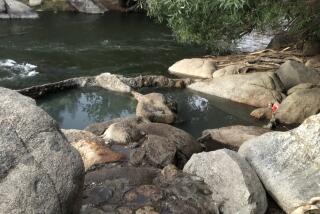Enduring heat and history, hikers learn their place -- far behind the ghosts of Hoover Dam

A few short tunnels provide the only shade for miles on the Railroad Trail.
The sign posted at the trailhead of our 8-mile hike does not bode well: “DANGER. Extreme Conditions! STOP. Do not hike Jun-Sep. HEAT KILLS!”
There’s more. “Tunnel 3 is full of bats,” warns a fellow hiker. “Bad smell.”
Still, we press on.
It’s a summer morning in the Mojave Desert: Temperatures already reach the high 80s and nature’s broiler is fired up to produce another 100-degree day. The sun seems to scoff in a Jersey accent common during the wiseguy era of casinos: “Whaddya gonna do about it?”
My friend Aaron Darsky and I are hiking the historic Railroad Trail, an outing that promises both scenery and history, greeting, so to speak, the ghosts of workers who toiled in the desert heat to build Hoover Dam.
Earlier this year, Interior Secretary Sally Jewell designated this old railroad right-of-way high above Lake Mead as a national recreation trail. I licked my hiking chops at the prospect of moseying on a footpath forged in 1931, during the Great Depression.
Until the dam’s completion in 1936, nine steam and gas locomotives chugged past Oregon fir ties, through five tunnels piercing volcanic mountains, delivering concrete mix to the man-made wonder.
The line was ripped up in 1962, the rails sold for scrap, and the old right-of-way became a trail traversed mostly by locals. The pathway played a cameo role in the 1977 film “The Gauntlet,” starring Clint Eastwood and Sondra Locke, in which a couple scampers along on a motorcycle, chased by an assassin in a helicopter.
As we set off, a chopper passes. No assassins. Just a bunch of tourists whisked over the shimmering lake.
A bead of sweat crosses my brow, along with panic. The only shade for miles is a few short tunnels carved into the rock. But as we pass old railroad ties in the wash, I get my groove back: The trail is flat, graded and graveled, wide enough for a freight train. You know, guys like us.
This hike’s gonna be easy, I observe. Piece of cake.
Like attorneys do, Aaron demurs: “We’ve only gone 300 yards.”
There’s an important difference in our pre-hike planning: Aaron prepared. I did not.
A 50-something lawyer from San Francisco, in decent shape from chasing all those ambulances, he’s slathered his large frame with sunblock, and he shoulders a 2-liter sack called a Platypus filled with ice-cold water, from which he guzzles like a thirsty elephant at a watering hole.
I have 50-ounce bottle of warm water. I eye his larder, planning to club him into submission for his water if the need arises. To his credit, Aaron offers to “buddy breathe” off his Platypus. No way, sucker, I think.
As it turns out, Aaron is a lawyer with some literary conceit. As he watches me scribble notes, he declares he will write his own version of the hike — the truth, he calls it, not just some journalist’s warped version of events. He promises satire and candor, touches of J.D. Salinger.
“Siri,” he says into his iPhone. “Take a note …”
Could he be some kind of threat? I wonder. My Lazlo — Hunter S. Thompson’s literary sidekick on his Las Vegas romps? But when I hear what Aaron is actually blathering to Siri, I take no further heed of his ramblings.
Soon, I lose my pen, and resort to dictation into my own iPhone.
We’re in trouble.
In four hours on the trail, we pass perhaps two dozen other overheated hikers on a penance of sorts — punishment for the casino excesses of the night before. There’s a man with his young daughter who looks like she isn’t wearing enough sunblock.
Then the first tunnel appears like a mirage. Inside, the temperature drops 20 degrees. Like most of the tunnels, it’s a short blast of coolness, maybe 100 yards long. Then the sunlight strikes again. My water’s half-gone.
But the Hoover Dam workers suffered far worse. A trail-side sign reads: “Hard Times in the Desert. If you had stood here in the early 1930s, you would have looked down on the wooden cabins, tattered tents and cardboard dwellings of Ragtown. Conditions were primitive; outhouses, no running water and no electricity.”
And the words of one resident: “I just don’t know how I stood it. There was very little fresh food or meat. The ants were absolutely our worst problem. The ants would beat you to the food.”
I look past the sign and Lake Mead mocks me: All that water and not a drop to drink. I look over at Aaron. We’re two large, sweaty men stumbling along in our own Sergio Leone film. I wonder whether he has ever read about the Donner Party.
Aaron yaps into his phone: “Whoever said the desert was beautiful has not walked this trail.”
The dude’s going negative. Sure, we’d passed fenced-off yards with old dam turbines. Tunnel 3 carried the whiff of Mexican free-tailed bat guano.
But unlike Aaron, I’m not a hater.
We trudge past power-line towers lumbering away from the dam like soldiers with tiny arms. A chuckwalla, a bulky lizard, scampers past. Aaron babbles into his phone about irradiated reptiles taking out the power grid. His water pouch, like the trail, has long gone bone-dry.
As we make our way back to the car, our hike is now a slog. “Knowing what you know now,” Aaron asks, “what’s worse: this hike, or getting stung in a private place by a scorpion?”
A woman with no water bottle passes in the direction of the dam. She asks the distance to the first tunnel.
“A mile,” I say. “Just past the body of the woman who didn’t bring enough water.”
“Oh, it’s not that hot,” she responds.
I think: Yeah, right. You’re gonna be sorry, lady.
Finally, the parking lot. We’ve completed our desert test — and I never clobbered Aaron for his water.
But unlike the dam workers of old, there was electricity, running water, even modern bathrooms — and not an ant in sight. I now appreciate the Ragtown residents who built the dam. They’re my new heroes.
Twitter: @jglionna
More to Read
Start your day right
Sign up for Essential California for news, features and recommendations from the L.A. Times and beyond in your inbox six days a week.
You may occasionally receive promotional content from the Los Angeles Times.







